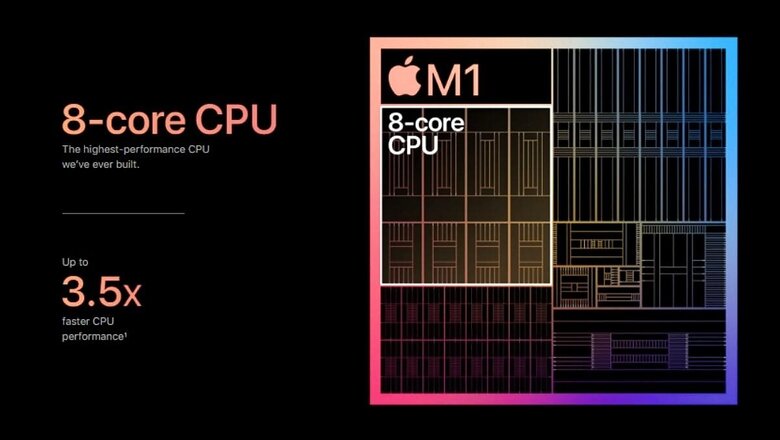
views
It has barely been a few weeks since Apple unleashed the ultra-powerful Apple Silicon, the Apple M1 chip with the new MacBook Air, MacBook Pro and the Mac Mini, but if you expected Apple to sit back and rest on its laurels, you’d be completely off the mark. It is now believed that the successor to the M1, dubbed the M1X at this time, is already doing rounds of the test labs and delivering some interesting test results. That is, if we are to believe the details shared online. There may be a strand of truth in these specific pieces of information, but even if not, the larger direction is very clear. Even more powerful Apple M-series chips are on the way. It is expected that the Apple M1X will pack in more cores and deliver even higher levels of performance, in comparison with the M1, which already leaves most of Intel’s current processors, far behind. It was always unlikely that Apple would offer just one processor option to all users.
The Apple M1X will have 12 cores instead of the 8 cores that the Apple M1 has, that is according to @LeaksApplePro. In the M1, there are four high performance cores and four cores meant for power efficiency. The Apple M1X is expected to be configured with eight high performance cores and four power efficiency cores. Mind you, the Apple M1 is incredibly powerful. The Apple MacBook Air, refreshed with the new M1 chip scored over a million points on AnTuTu, a synthetic benchmark which does show how much the new chip can flex its muscles. This makes it the first laptop chip to clock the million score—mind you, these are benchmark tests largely irrelevant in the real world but does give you a fair idea of how far ahead the M1 is in comparison with anything else in the mobile computing space. That is exactly why Apple is making the switch from Intel.
Next step in that evolution will be the Apple M1X chip. It is quite possible that Apple will keep the 7 cores and 8 cores variants of the M1 chip alongside the expected 12 cores laden Apple M1X, with these being positioned for different machines and specifications. If you are well versed with the Intel processor line-up, Apple’s version of the Core i5 and the Core i7 and indeed the Core i9 families, positioned at different price points for different usage scenarios and form factors. The Apple M1X could be used in the upcoming Apple MacBook Pro 16, for instance. Then there is the Apple iMac line as well as the Mac Pro which await the switch from Intel processors to Apple’s own chips—something that should most certainly happen next year.
Speaking of which, the Apple MacBook Pro 16 refresh for next year is hugely awaited. The flagship MacBook should ideally usher in the newer processor and the performance boost it brings. It may be possible that Apple could use this chip as the big differentiator between the MacBook Pro 16 and the MacBook Pro 13, if it wants to make that distinction that is.
There is expectation, largely revolving around analyst Ming Chi Kuo’s claims, that there could be a 14-inch Apple MacBook Pro on the way. Will that replace the MacBook Pro 13, we do not know. Theoretically, it may be a like-for-like replacement the way the MacBook Pro 16 was for the MacBook Pro 15. Will that get the Apple M1 or the expected Apple M1X chips, hard to say.
Then there are the Apple iMacs. Refreshed in the second half of 2020, the iMac 21.5-inch and the iMac 27 should most likely make the switch away from Intel’s chips with the next update. It may also be time for a design refresh. While it has become slimmer and there have been refinements along the way, the larger design of the iMacs has remained the same since the refresh in 2012.
Apple could also look at both processor variants for the same families of Macs as well. For instance, we could have the lower spec and more affordable of the MacBook Pro 13 run the 8 core Apple M1 which the more powerful configurations could get the 12-core iteration of the Apple M1X—either by default or as an optional configure your Mac upgrade.
Could it also become a situation where the entire or even a part of the Mac computing line-up gets unsaid subdivisions into the less powerful and more powerful brackets, with the former running the M1 and the latter running the M1X? At least with the default configurations on sale, before the customizations? MacBook Pro 13 and the MacBook Pro 16 for instance. The iMac 21.5-inch and the iMac 27-inch, for instance. Will switching to a larger screen bring with it comparative more powerful performance? Or you configure according to your needs without having to move to a larger display size?
Apple has maintained that there are more Intel powered Mac computing devices to come. It is hard to see how, and where they would fit amidst the significantly superior performance that the Apple M1 offers, both in terms of outright speed and battery life. It was always supposed to be a two-year switch cycle, starting a few weeks ago when the new MacBook Air, new MacBook Pro 13 and the new Mac Mini were released. We may see the end of Intel’s run with the Apple Macs by the time the year 2021 closes.
Read all the Latest News, Breaking News and Coronavirus News here



















Comments
0 comment